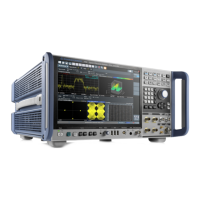Measurements and Results
R&S
®
FSW
181User Manual 1173.9411.02 ─ 43
The inherent noise of the instrument depends on the selected center frequency, resolu-
tion bandwidth and level setting. Therefore, the correction function is disabled when-
ever one of these parameters is changed. A disable message is displayed on the
screen. To enable the correction function after changing one of these settings, activate
it again. A new reference measurement is carried out.
Noise cancellation is also available in zero span.
Currently, noise cancellation is only available for the following trace detectors (see
"Detector" on page 584):
●
RMS
●
Average
●
Sample
●
Positive peak
Remote command:
[SENSe:]POWer:NCORrection on page 1041
Selected Trace
The CP/ACLR measurement can be performed on any active trace.
Remote command:
[SENSe:]POWer:TRACe on page 841
Absolute and Relative Values (ACLR Mode)
The powers of the adjacent channels are output in dBm or dBm/Hz (absolute values),
or in dBc, relative to the specified reference Tx channel.
"Abs"
The absolute power in the adjacent channels is displayed in the unit
of the y-axis, e.g. in dBm, dBµV.
"Rel"
The level of the adjacent channels is displayed relative to the level of
the transmission channel in dBc.
Remote command:
[SENSe:]POWer:ACHannel:MODE on page 891
Channel power level and density (Power Unit)
By default, the channel power is displayed in absolute values. If "/Hz" is activated, the
channel power density is displayed instead. Thus, the absolute unit of the channel
power is switched from dBm to dBm/Hz.
Note: The channel power density in dBm/Hz corresponds to the power inside a band-
width of 1 Hz and is calculated as follows:
"channel power density = channel power – log
10
(channel bandwidth)"
Thus you can measure the signal/noise power density, for example, or use the addi-
tional functions Absolute and Relative Values (ACLR Mode) and Reference Channel to
obtain the signal to noise ratio.
Remote command:
CALCulate<n>:MARKer<m>:FUNCtion:POWer<sb>:RESult:PHZ on page 890
Channel Power and Adjacent-Channel Power (ACLR) Measurement

